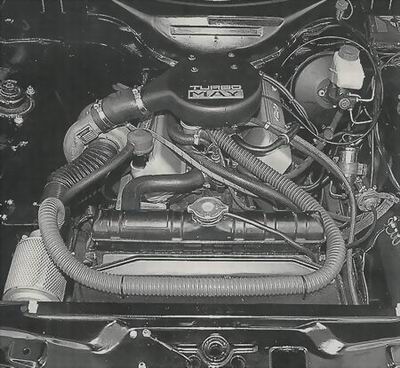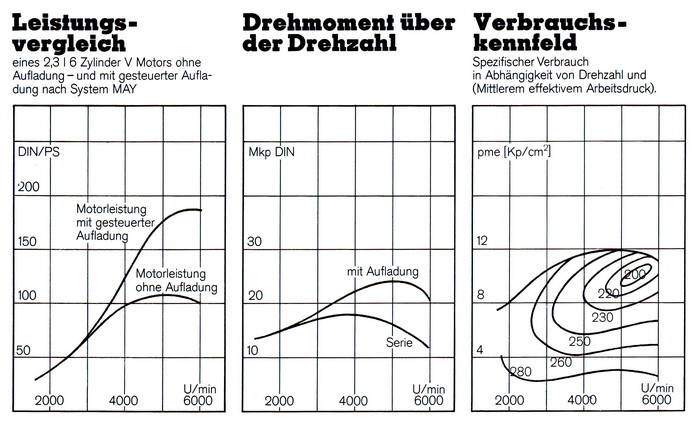|
|
|
| Capri I 2300 GT mit May Turbolader - Die sanfte Gewalt mit Turbo May Aufladung |
Teil / Part 3 - Turbo May Motor |
Auch die Frage nach Lebensdauer und zusätzlichem
Verschleiss des Motors ergibt positive Werte.
Da der Motor nicht höher dreht, ist die Belastung
der auftretenden Massenkräfte
(von Kolben, Pleuel, Kolben-Bolzen) nicht grösser.
Die Turbo-May Aufladung für den Ford Motor ist so
abgestimmt, dass der Motor bis ca. 3200 U/Min.
wie ein konventioneller Saugmotor gleichen Typs läuft
und behandelt werden kann.
Der Fahrer hat nicht den Eindruck ein getuntes Fahrzeug
zu fahren das die nahezu doppelte Katalogleistung (108
PS zu 180 PS) aufweist.
Elastizität, Startwilligkeit, schlechthin die Alltagstauglichkeit
sind voll erhalten geblieben.
Ab ca. 3500 U/Min. Motordrehzahl (der Lader dreht jetzt
ca. 30'000 U/Min. und erzeugt einen Ladedruck von ca.
0.15 bar) gelangt der Turbolader in Drehzahlbereiche,
die ihm zu einem vernünftigen
Wirkungsgrad verhelfen.
Das Drehmoment steigt mit zunehmender Drehzahl immer mehr
an, wo es beim Saugmotor längst
seinen Maximalwert überschritten hat.
Die höchste Leistung von 180 DIN PS erreicht der
Motor bei 5750 U/Min.
(Der Lader dreht dort ca. 70'000 U/Min.) und erzeugt einen
Ladedruck von ca. 0,7 bar.
Beachtenswert ist die Geräuschentwicklung im "Turbo-Ford".
Im innern des Wagens überhaupt nichts zu spüren,
verkündet die abgestimmte Auspuffanlage lediglich
durch einen kernigen Ton der Aussenwelt,
dass da etwas besonderes daran sein muss.
Ein weiteres Plus des turbogeladenen Motors ist die Wartung.
Die Turbolader Gruppe mit sämtlichen Nebenaggregaten
benötigt keine Wartung. Die Kugellager werden über
eine an den Motorenölkreislauf angeschlossene Leitung
geschmiert und hauptsächlich gekühlt. Der restliche
Motor wird normal gewartet.
Die grosse Stärke des aufgeladenen Motors liegt nicht
in der höheren Spitzengeschwindigkeit, vielmehr wird
jedes Überholmanöver zum risikolosen Vergnügen. |
The question of service life and additional wear of the motor also results in positive values.
Since the motor does not rotate any higher, the load of the occurring inertia forces is reduced.
(from piston, connecting rod, piston pin) not larger.
The Turbo-May turbocharging for the Ford engine is tuned in such a way that the engine can reach up to 3200 rpm. how a conventional naturally aspirated engine of the same type runs and can be treated.
Elasticity, willingness to start, and the everyday suitability have been fully preserved.
From approx. 3500 rpm. Engine speed (the turbocharger now turns about 30'000 rpm and generates a boost pressure of about 0.15 bar) the turbocharger reaches speed ranges which help it to achieve a reasonable efficiency.
Torque increases with increasing speed, where it has long since exceeded its maximum value in the naturally aspirated engine.
The engine achieves the highest output of 180 DIN PS at 5750 rpm.
(The loader turns there approx. 70,000 rpm) and generates a boost pressure of approx. 0.7 bar.
The noise level in the Turbo-Ford is remarkable. In the interior of the car nothing to feel at all, the tuned exhaust system only announces by a hearty tone of the outside world that there must be something special about it.
Another advantage of the turbocharged engine is its maintenance. The turbocharger group with all auxiliary units does not require any maintenance. The ball bearings are lubricated and mainly cooled via a line connected to the motor oil circuit. The rest of the engine is maintained normally.
The great strength of the supercharged engine is not in the higher top speed, but rather every overtaking manoeuvre becomes a risk-free pleasure. |
» Teil / Part 4
Capri I | Capri II | Capri III (II/78)
|




